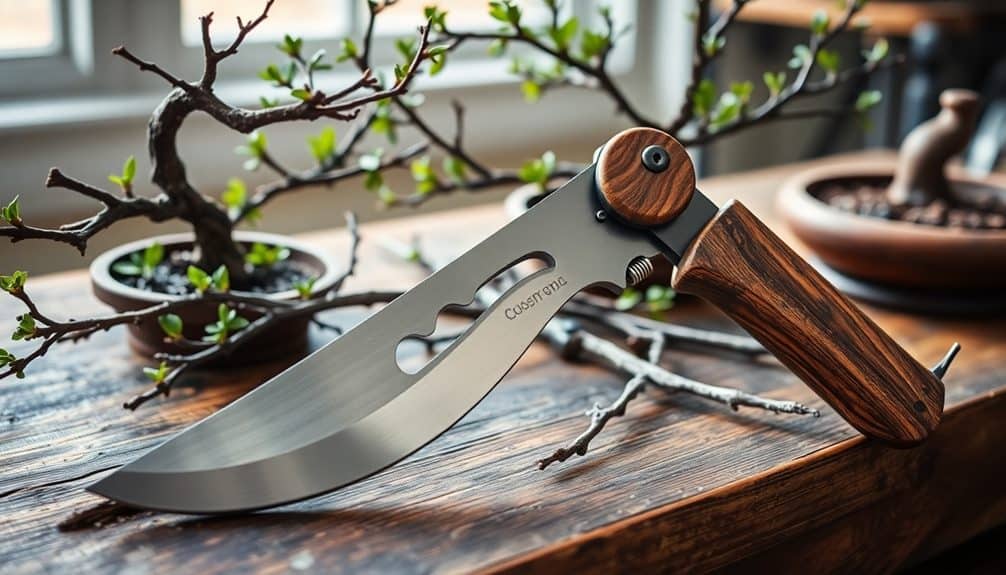This website contains affiliate links. Some products are gifted by the brand to test. As an Amazon Associate, I earn from qualifying purchases. The content on this website was created with the help of AI.
For professional-grade pruning in 2024, you’ll find the Vouiu 8-Inch Concave Cutter leading the pack with its durable stainless steel construction and precise cuts. The BambooMN Bonsai Basics Set offers excellent value for beginners, while the premium Wazakura Hand-Forged Cutter delivers unmatched Japanese craftsmanship. The Branch Cutter with Ergonomic Handles stands out for its comfort during extended use, and the Precision-Engineered 210mm model impresses with its manganese steel durability. Each tool brings unique strengths to your gardening arsenal, and understanding their specific features will help you make the perfect choice for your pruning needs.
Key Takeaways
- The Wazakura Hand Forged Bonsai Concave Branch Cutter leads professional rankings with S55C carbon steel construction and precise 25mm blades.
- Vouiu’s 8-Inch Concave Cutter offers excellent value with stainless steel durability and an offset cutting edge for flush cuts.
- The Precision-Engineered 210mm model features premium manganese steel and ergonomic curved handles for extended professional use.
- BambooMN’s Bonsai Basics Set provides high-carbon steel quality at an entry-level price point suitable for beginners.
- The 6.4-inch Branch Cutter with Ergonomic Handles delivers professional precision with 62 HRC hardness rating and lightweight maneuverability.
8inch Concave Cutter Bonsai tools
- Used for pruning bonsai fork branches
- Cutting edge offset design
- Material: Stainless Steel
For bonsai enthusiasts seeking professional-grade pruning tools, the Vouiu 8-inch concave cutter stands out with its stainless steel construction and precision-oriented design. At 210mm in length, this tool offers excellent leverage while maintaining comfortable handling for precise cuts.
You’ll find the offset cutting edge particularly useful when working with fork branches, as it allows for clean, flush cuts that promote healthy healing. While primarily designed for bonsai work, you can also use it for horse hoof maintenance, thanks to its robust build and sharp blade.
The tool’s versatility makes it suitable for both beginners and experienced users, though you might notice some variation in performance across different branch sizes. With Amazon’s 30-day return policy, you can test the tool’s effectiveness for your specific needs without risk.
Best For: Bonsai enthusiasts and DIY horse hoof care practitioners who need a reliable, sharp tool for precise cutting and trimming work.
Pros:
- High-quality stainless steel construction with polished finish
- Versatile usage for both bonsai work and horse hoof maintenance
- Comfortable handling with good leverage for clean cuts
Cons:
- Inconsistent performance on varying branch sizes
- Quality control issues reported by some users
- Higher price point compared to basic pruning tools
BambooMN Bonsai Basics Set – 8 Concave Cutter, 7 Heavy Duty Shear – 1 Set
- CONTENTS Comes with 1 Concave Cutter and 1 Heavy Duty Shear
- DIMENSIONS Concave Cutter is 8" (20.3cm) and the Heavy Duty Shear is 7" (17.7cm)
- COMPOSITION The shears and cutters are hand forged from high-quality carbon steel
Bonsai enthusiasts seeking an entry-level tool set will find the BambooMN Basics Set a practical starting point. This set includes an 8″ concave cutter and a 7″ heavy-duty shear, both hand-forged from high-carbon steel.
You’ll appreciate the concave cutter’s ability to prune branches close to the trunk while leaving minimal scarring, while the shears excel at precise cuts in tight spaces. The tools perform well on non-woody limbs, though you might need extra effort for larger twigs.
To maintain these tools, you’ll need to wipe them clean and apply oil after each use to prevent rust, especially in humid conditions. While they’re not professional-grade instruments, they’ll serve you well as you learn bonsai basics before investing in higher-end equipment. These tools are particularly popular among bonsai clubs for new members.
Best For: Beginner bonsai enthusiasts looking for an affordable, basic tool set to learn fundamental pruning and shaping techniques.
Pros:
- Hand-forged carbon steel construction offers good durability for the price point
- Concave cutter creates clean cuts close to the trunk with minimal scarring
- Practical two-tool combination covers most basic bonsai maintenance needs
Cons:
- Requires frequent maintenance to prevent rusting
- May struggle with larger or woody branches
- Quality level suitable for beginners but will need upgrading as skills advance
Wazakura Hand Forged Bonsai Concave Branch Cutter (200mm)
- 【Specification】Size: L 7.87 x W 1.96 x H 0.78 in (200 x 50 x 20 mm) | Length of Blades: 0.98 in (25 mm) | Weight: 6.7 oz (190 g) | Material: S55C...
- 【Made in Japan by local blacksmith artisans】Real Japanese bonsai tools handforged by blacksmith artisans specialized in bonsai tools from the city...
- 【Little Scarring in Branches Up to 13mm】Essential bonsai tool for branches ranging from 5/16" to 1/2" (8mm to 13mm). Ideal for pruning and...
Japanese craftsmanship meets precision engineering in the Wazakura Hand Forged Bonsai Concave Branch Cutter, a premium tool that’s essential for serious bonsai artists who won’t compromise on quality. Hand-forged by skilled blacksmiths in Sanjo, Japan, this 200mm cutter features S55C carbon steel blades with a black coating for ideal performance.
You’ll appreciate its precise 25mm concave blades that handle branches from 8mm to 13mm with minimal scarring. At 190g, it’s perfectly balanced for comfortable use. While it excels in bonsai work, you can also use it for other precise pruning tasks. The tool requires proper maintenance – a light coating of camellia seed oil after use will prevent rust and maintain its superior cutting edge. It comes beautifully packaged in a black gift box with gold embossing, making it an impressive gift for any serious gardener.
Best For: Professional bonsai artists, serious hobbyists, and precision gardeners seeking a premium-quality Japanese hand-forged tool for precise branch cutting and shaping.
Pros:
- Exceptional Japanese craftsmanship with hand-forged S55C carbon steel construction
- Precise concave blade design creates minimal scarring for healthier tree healing
- Versatile cutting capacity (8-13mm) with comfortable weight balance and grip
Cons:
- Requires regular maintenance with oil to prevent rust
- Premium price point may be prohibitive for casual users
- Limited to smaller branch sizes (up to 13mm) compared to larger pruning tools
Branch Cutter Bonsai Tools with Ergonomic Handles
- Ideal for trimming branches, even flowers, fruit trees, bonsai, garden plants, garden plants, indoors or outdoors.
- Made of high quality material, it is of high hardness, strong tenacity and wearability.
- Excellent workmanship, especially adopts ice calcination treatment, has good sharpness.
Looking for professional-grade pruning precision with maximum comfort? This 6.4-inch branch cutter combines durability with ergonomic design, making it ideal for extended bonsai and gardening sessions. At just 5.8 ounces, it’s lightweight enough for all-day use without sacrificing cutting power.
The tool’s composite steel construction and 62 HRC hardness rating guarantee reliable performance across various branch types and sizes. You’ll appreciate the ergonomic handles that reduce hand fatigue during long pruning sessions, whether you’re working on indoor bonsai or outdoor fruit trees. The 16.3cm length provides excellent maneuverability while maintaining cutting strength.
If you’re not satisfied, you’ll have 30 days to return it through Amazon’s guarantee policy. For professional-grade results in bonsai maintenance and general garden care, this concave cutter delivers precision where you need it most.
Best For: Bonsai enthusiasts and gardeners seeking a professional-grade branch cutter that offers precision cutting with ergonomic comfort for extended pruning sessions.
Pros:
- Ergonomic handles reduce hand fatigue during long periods of use
- High-quality composite steel construction with 62 HRC hardness ensures durability and cutting power
- Lightweight design at 5.8 ounces makes it easy to maneuver and carry
Cons:
- At 6.4 inches, may be too short for reaching higher branches
- Premium price point compared to basic pruning tools
- Limited to smaller branch sizes due to its compact design
Bonsai Concave Cutter (210mm)
- High Quality Workmanship: Our branch cutter made of high quality manganese steel alloy, with fine workmanship and sharp blades. Bonsai cutting machine...
- Application: Use our concave cutter to safely remove branches and reduce scars. The circular end ensures that your tree remains healthy and undamaged....
- Efficient Cutting Blade: Concave cutter bonsai with short and precisely aligned cutting blades to easily remove training wires without damaging your...
Serious bonsai enthusiasts will appreciate the precision-engineered 210mm concave cutter, crafted from premium manganese steel alloy. You’ll find the sharp, perfectly aligned blades equipped with a round edge knob ideal for removing training wires, small knots, and unwanted bumps with minimal tree damage.
The 8.4-inch tool’s ergonomic design features curved handles with a black matt patina, allowing you to work for extended periods without hand fatigue. Its circular end design promotes quick healing while effectively removing bark and fibers at a concave angle. The tool’s durability stands out with its rust-proof, wear-resistant properties and strong toughness.
Users consistently praise this cutter’s sharpness and precision control, noting it performs comparably to higher-priced alternatives. If you encounter any packaging issues, you’ll have access to responsive customer support.
Best For: Serious bonsai practitioners and hobbyists seeking a professional-grade tool for precise branch cutting, wire removal, and knot elimination at a mid-range price point.
Pros:
- High-quality manganese steel construction provides excellent durability and rust resistance
- Ergonomic curved handles with matt patina enable comfortable extended use
- Circular end design minimizes tree damage and promotes faster healing
Cons:
- 210mm length may be too large for working with very small bonsai specimens
- Premium price point compared to basic pruning tools
- May require periodic maintenance to maintain optimal sharpness
Factors to Consider When Choosing Concave Branch Cutters

When you’re selecting a concave branch cutter, you’ll need to evaluate several essential factors that affect both performance and longevity. Your primary considerations should include the material quality and durability of the tool’s construction, the precision of the blade size and sharpness, the ergonomics of the handle design, and the tool’s required maintenance schedule. The cutting capacity range must also match your specific needs, as different models are designed to handle varying branch thicknesses and wood densities.
Material Quality and Durability
The three most essential aspects of concave branch cutters lie in their material quality and durability. When you’re investing in these tools, you’ll want to focus on materials that offer superior hardness and resistance to everyday wear. High carbon steel and stainless steel stand out as top choices, providing excellent durability while maintaining their cutting efficiency.
You’ll find that manganese steel alloy tools are particularly worth considering, as they’re engineered to maintain sharp edges even after repeated use. These tools combine strength with toughness, making them ideal for regular pruning work. If you’re looking for exceptional quality, hand-forged cutters often deliver superior craftsmanship and longer-lasting performance compared to mass-produced options.
To protect your investment, you’ll need to implement proper maintenance routines, especially if you choose carbon steel tools. Regular oiling and storage in dry environments will prevent rust and extend your tool’s lifespan. When evaluating durability, look for cutters that demonstrate solid construction throughout – from the blade to the handles. A well-made concave cutter should maintain its structural integrity and cutting precision even with frequent use.
Blade Size and Sharpness
Selecting the right blade size and maintaining proper sharpness greatly impacts your pruning efficiency. When choosing concave branch cutters, you’ll find blade sizes ranging from 6.4 to 8.4 inches. Smaller blades offer better maneuverability in tight spaces, while larger ones provide more cutting power for thicker branches. Consider your specific pruning needs and the size of branches you’ll typically work with.
Blade sharpness is vital for making clean, precise cuts that promote healthy plant growth. You’ll want to look for cutters made from high-quality materials like carbon steel or manganese steel alloy, as they retain their edge longer and deliver consistent performance. These materials guarantee your cuts are clean and flush against the branch, minimizing scarring and allowing for quicker healing.
Don’t forget that maintaining your cutters is essential for peak performance. You’ll need to oil the blades regularly to prevent rust and preserve sharpness. Sharp blades reduce the effort required for cutting and prevent unnecessary damage to plants. When your blades stay sharp, you’ll make cleaner cuts that support better plant health and recovery.
Handle Design and Comfort
Properly designed handles consistently make the difference between comfortable, efficient pruning and hand fatigue. When you’re selecting a concave branch cutter, you’ll want to pay special attention to the ergonomic features that match your specific needs and working style.
Look for handles with curved designs that naturally conform to your hand’s shape. These ergonomic curves help distribute pressure evenly across your palm and fingers, preventing stress points that can lead to discomfort during extended pruning sessions. You’ll find that rubberized or textured grip surfaces offer considerable advantages, as they’ll help you maintain control even in wet conditions or when you’re wearing gardening gloves.
Consider the tool’s weight carefully – lighter models will help you maintain precision throughout long pruning sessions without compromising cutting power. The handle length is equally important; longer handles provide better leverage for tackling thick branches, but they shouldn’t be so long that they become unwieldy. You’ll want to test how the tool feels in your hands, as the right balance between weight, length, and grip design will considerably impact your pruning efficiency and overall comfort.
Maintenance Requirements
Before investing in concave branch cutters, you’ll need to contemplate their maintenance requirements, as different materials and designs demand varying levels of care. Carbon steel models require the most attention – you’ll need to oil them after each use to prevent rust and maintain their cutting performance. While this might seem demanding, proper care guarantees these tools stay sharp and effective.
If you’re looking for lower-maintenance options, consider stainless steel cutters. They’re more resistant to rust and corrosion, though they’ll still benefit from periodic cleaning and oiling. Regardless of the material you choose, you’ll want to store your cutters in a dry environment to protect them from humidity-related damage.
Should you notice any rust developing on your tools, don’t panic – you can usually address this by buffing the affected areas with fine sandpaper. Remember that investing time in maintenance pays off in the long run. With proper care, your concave branch cutters can serve you effectively for many years, maintaining their sharp edges and smooth cutting action. The key is establishing a regular maintenance routine that matches your chosen tool’s specific needs.
Cutting Capacity Range
One of the most essential factors in choosing concave branch cutters is understanding their cutting capacity range, which typically spans from 5/16 to 1/2 inches (8mm to 13mm) in diameter. You’ll want to carefully match your tool’s capacity to the specific branch sizes you commonly work with in your bonsai or gardening projects.
When you’re dealing with larger branches, you’ll need cutters specifically designed with reinforced structures and stronger blades to handle the increased stress during cutting. These heavy-duty tools guarantee clean cuts without damaging the tool itself. Conversely, if you’re primarily working with smaller branches, you might prefer cutters with shorter, precisely aligned blades that offer enhanced cutting efficiency.
Getting the right cutting capacity isn’t just about convenience – it’s critical for your plants’ health. If you use a cutter that’s not suited to your branch size, you risk causing excessive scarring and slower healing times. By selecting a tool that matches your typical cutting needs, you’ll achieve cleaner cuts that promote faster healing and maintain the overall health of your plants.
Price Vs Quality Balance
Finding the right balance between price and quality shapes every aspect of choosing concave branch cutters for your gardening toolkit. When you’re evaluating your options, you’ll notice that premium tools made from hand-forged carbon steel or stainless steel command higher prices, but they deliver superior performance and longevity that can justify the investment.
While you might be tempted to opt for budget-friendly alternatives, especially if you’re just starting out, consider how a higher-quality tool can improve your pruning results. Premium cutters typically provide cleaner cuts that promote better plant healing and reduce the need for frequent maintenance. This long-term benefit often outweighs the initial cost difference.
Don’t forget to factor in the manufacturer’s warranty and customer support when weighing your options. Well-established brands typically back their products with extensive warranties against defects, adding significant value to your purchase. If you’re an experienced gardener who regularly maintains bonsai or ornamental trees, you’ll likely find that investing in a premium concave cutter pays off through improved precision, durability, and overall cutting experience.
Tool Weight and Length
Tool weight and length represent two vital factors that directly impact your pruning effectiveness and comfort. When selecting a concave branch cutter, you’ll need to take into account how these elements align with your specific gardening needs and physical capabilities.
The length of your cutter, typically ranging from 6.4 to 8.4 inches, will determine your reach and control. If you’re working with distant branches, you’ll want to opt for a longer tool, but keep in mind that this may reduce precision in confined spaces. Shorter cutters offer better maneuverability for detailed pruning work, making them ideal for bonsai and ornamental shrubs.
Weight plays an equally vital role in your pruning experience. While heavier cutters often indicate robust construction and durability, they can lead to faster fatigue during extended use. Lighter tools enhance maneuverability and reduce strain but may not provide the same stability during tough cuts. Take into account your pruning frequency and duration when choosing between weight options. If you’re planning lengthy pruning sessions, you’ll benefit from an ergonomically designed tool that balances weight distribution to minimize hand and arm fatigue.
Frequently Asked Questions
How Often Should I Sharpen My Concave Branch Cutter?
You’ll need to sharpen your concave branch cutter every 3-4 months if you’re using it regularly. Watch for signs like increased effort when cutting or rough, jagged cuts—these indicate it’s time to sharpen. After each use, clean the blade and apply light oil to prevent rust. If you’re a heavy user, you might need to sharpen monthly, while occasional users can go 6 months between sharpenings.
Can Concave Branch Cutters Be Used on Regular Garden Plants?
While you can use concave branch cutters on regular garden plants, they’re specifically designed for bonsai pruning to create clean, concave cuts that heal quickly. For typical garden plants, you’ll be better off using standard pruning shears or loppers, which are more suitable for straight cuts. If you use concave cutters on regular plants, you might damage the tool or create unnecessary wounds that could harm your plants.
What’s the Maximum Branch Diameter These Cutters Can Safely Handle?
As they say, “The right tool for the right job” is essential in gardening. You’ll find that most concave branch cutters can safely handle branches up to 1 inch (25mm) in diameter. If you’re dealing with anything thicker, you’re better off using a larger tool like loppers or a pruning saw. Pushing beyond this limit won’t just damage your cutters – it’ll risk creating jagged cuts that can harm your plants.
Are Replacement Parts Available for High-End Concave Branch Cutters?
You’ll find that replacement parts are available for premium concave branch cutters, but it depends on the brand and model. You can usually get new springs, blades, and handles from the manufacturer or authorized dealers. If you’ve invested in a high-end tool like ARS or Fujiwara, you’re in luck – they typically offer excellent parts support. However, you’ll want to check availability before purchasing, as some parts may require special ordering.
Should Concave Cutters Be Oiled After Each Use?
Picture your prized concave cutters slowly developing rust and stiffness. That’s what you’ll face if you don’t oil them properly. You’ll want to clean and oil your cutters after each use to prevent rust, maintain smooth operation, and extend their lifespan. Don’t just use any oil – stick to light machine oil or specialized tool oil. It’s quick and simple: wipe them clean, apply a thin coat, and you’re done.









